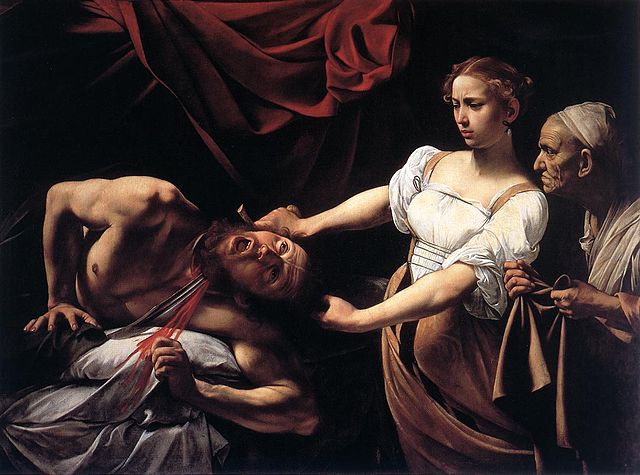
File:Caravaggio Judith Beheading Holofernes.jpg

| |
This is a file from the Wikimedia Commons. Information from its description page there is shown below.
Commons is a freely licensed media file repository. You can help. |
Summary
| DescriptionCaravaggio Judith Beheading Holofernes.jpg |
English: Caravaggio's art
Français : Le Caravage, Judith décapitant Holopherne
|
||||||||||||||||||||||||||
| Date | |||||||||||||||||||||||||||
| Source | http://www.allartpainting.com/judith-beheading-holofernes-p-1534.html | ||||||||||||||||||||||||||
| Author |
|
||||||||||||||||||||||||||
Licensing
The official position taken by the Wikimedia Foundation is that "faithful reproductions of two-dimensional public domain works of art are public domain, and that claims to the contrary represent an assault on the very concept of a public domain". For details, see Commons:When to use the PD-Art tag. |
|||||
File usage
Metadata
| JPEG file comment | CARAVAGGIO (b. 1573, Caravaggio, d. 1610, Porto Ercole) Judith Beheading Holofernes c. 1598 Oil on canvas, 145 x 195 cm Galleria Nazionale d'Arte Antica, Rome A whole book in the Bible is devoted to Judith, because as a woman she embodies the power of the people of Israel to defeat the enemy, though superior in numbers, by means of cunning and courage. She seeks out Holofernes in his tent, makes him drunk, then beheads him. The sight of their commander's bloodstained head on the battlements of Bethulia puts the enemy to flight. In the painting, Judith comes in with her maid - surprisingly and menacingly - from the right, against the direction of reading the picture. The general is lying naked on a white sheet. Paradoxically, his bed is distinguished by a magnificent red curtain, whose colour crowns the act of murder as well as the heroine's triumph. The first instance in which Caravaggio would chose such a highly dramatic subject, the Judith is an expression of an allegorical-moral contest in which Virtue overcomes Evil. In contrast to the elegant and distant beauty of the vexed Judith, the ferocity of the scene is concentrated in the inhuman scream and the body spasm of the giant Holofernes. Caravaggio has managed to render, with exceptional efficacy, the most dreaded moment in a man's life: the passage from life to death. The upturned eyes of Holofernes indicate that he is not alive any more, yet signs of life still persist in the screaming mouth, the contracting body and the hand that still grips at the bed. The original bare breasts of Judith, which suggest that she has just left the bed, were later covered by the semi-transparent blouse. The roughness of the details and the realistic precision with which the horrific decapitation is rendered (correct down to the tiniest details of anatomy and physiology) has led to the hypothesis that the painting was inspired by two highly publicized contemporary Roman executions; that of Giordano Bruno and above all of Beatrice Cenci in 1599.
--- Keywords: -------------- Author: CARAVAGGIO Title: Judith Beheading Holofernes Time-line: 1551-1600 School: Italian Form: painting Type: religious |
|---|
Find out more
Wikipedia for Schools was collected by SOS Children. More than 2 million people benefit from the global charity work of SOS Children's Villages, and our work in 133 countries around the world is vital to ensuring a better future for vulnerable children. If you'd like to help, why not learn how to sponsor a child?


